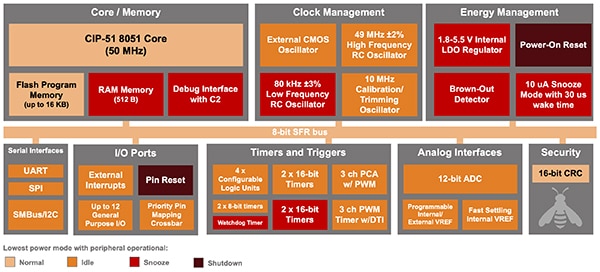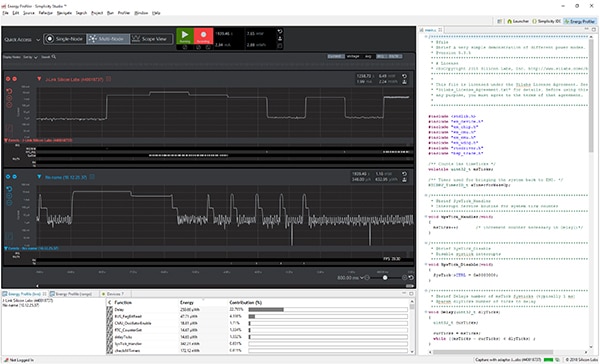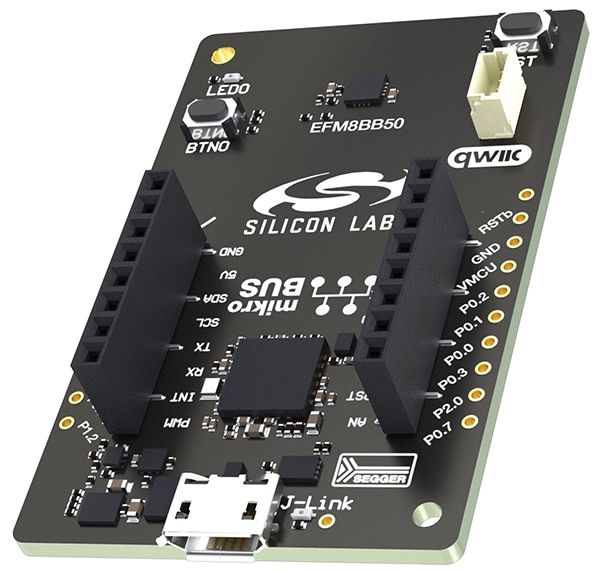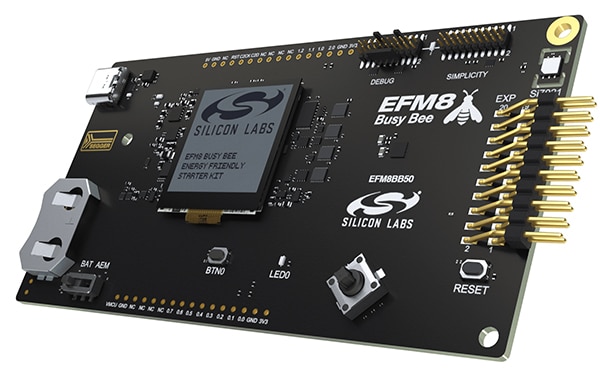Use an Optimized 8-Bit Microcontroller to Simplify the Design of Resource-Constrained Devices
Contributed By DigiKey's North American Editors
2024-04-09
For designers of power-constrained and space-constrained devices such as power tools, personal hygiene products, toys, appliances, and lighting controls, an 8-bit microcontroller unit (MCU) has traditionally sufficed. However, as applications evolve, they require higher speed, more powerful peripheral options, and more robust software development tools. Migrating to a 16-bit or 32-bit alternative can help, but often at the cost of a larger package size and more power.
To address these issues, designers can take advantage of MCUs based on the 8051 architecture that bring many of the benefits of 16-bit and 32-bit processors to the 8-bit domain. They do so in a package as small as 2 x 2 millimeters (mm) while offering a modern development environment.
This article briefly describes the 8051 architecture and its suitability for resource-constrained applications. It then introduces a family of 8051-based MCUs from Silicon Labs, describes major subsystems, and shows how each addresses critical design challenges. The article concludes by discussing hardware and software support.
Why use the 8051 architecture?
When selecting an MCU for a highly space-constrained application, 8-bit processors such as the well-established 8051 offer many advantages, including a small footprint, low power consumption, and a simple design. However, many 8051 processors have relatively simple peripherals, limiting their suitability for specific use cases. For example, low-resolution analog-to-digital converters (ADCs) are insufficient for high-precision applications such as medical devices.
Relatively slow clocks can also be an issue. The typical 8051 MCU operates at clock frequencies of 8 megahertz (MHz) to 32 MHz, and older designs require multiple clock cycles to process instructions. This low speed can limit the ability of 8-bit MCUs to support real-time operations such as precise motor control.
Also, the traditional software development environments for 8051 processors are misaligned with modern software developers' expectations. When combined with the inherent limitations of an 8-bit architecture, this can lead to a slow, frustrating coding process.
The limitations of traditional 8-bit processors may lead developers to consider migrating to 16-bit or 32-bit MCUs. While these MCUs offer ample computing power, high-performance peripherals, and modern software environments, they are also relatively large. This makes it more challenging to integrate them into space-constrained designs, which may delay development or increase design size.
The increased code size and power consumption associated with 16-bit and 32-bit MCUs can also lead to suboptimal designs. These drawbacks are particularly problematic for the many applications that do not involve complex mathematics and thus do not benefit from the advanced capabilities of these processors.
The ideal balance of these tradeoffs may not be evident at the start of a project, and switching processors mid-design can delay development or compromise product size or functionality. Thus, many space-constrained designs can benefit from a more capable 8051-based MCU that brings many of the advantages of 16-bit and 32-bit processors to the low-power, compact, 8-bit domain.
EFM8BB50 brings greater functionality to 8 bit MCUs
Silicon Labs built the EFM8BB50 family of 8-bit MCUs with these considerations in mind (Figure 1). These MCUs offer enhanced performance, advanced peripherals, and a modern software development environment.
 Figure 1: Shown is a block diagram of the EFM8BB50 MCU. (Image source: Silicon Labs)
Figure 1: Shown is a block diagram of the EFM8BB50 MCU. (Image source: Silicon Labs)
The heart of the MCU is the CIP-51 8051 core, a Silicon Labs implementation of the 8051 architecture optimized for increased performance, reduced power consumption, and enhanced functionality. The performance is particularly noteworthy. In the EFM8BB50, the core achieves speeds up to 50 MHz, and 70% of the instructions execute in one or two clock cycles. This gives the MCUs considerably higher performance than traditional 8-bit processors, providing developers headroom for more complex applications.
The MCUs are also notable for their diminutive dimensions. The 16-pin variants of the family, such as the EFM8BB50F16G-A-QFN16, are available in packages as small as 2.5 mm x 2.5 mm. The 12-pin versions such as the EFM8BB50F16G-A-QFN12 are even smaller, with package sizes down to 2 mm x 2 mm.
Despite their tiny dimensions, the EFM8BB50 MCUs are packed with an impressive array of features, including:
- A 12-bit ADC, which is essential for applications requiring accurate sensor data
- An integrated temperature sensor that enables the MCU to monitor its internal temperature or the ambient temperature without the need for external components
- A three-channel programmable counter array (PCA) with pulse-width modulation (PWM) that can generate PWM signals for variable output control in applications such as motor control and LED dimming
- A three-channel PWM engine with dead-time insertion (DTI) for added control of power electronics, such as motor drivers or power converters
Other input/outputs (I/O) include a variety of serial communications interfaces, a set of 8-bit and 16-bit timers, and four configurable logic units. All pins in the MCU family are 5-volt capable, and the digital I/O can be flexibly assigned to make the most of the limited pin count.
Advanced power management
The EFM8BB50 incorporates several energy management features to optimize power consumption and extend battery life. These start with multiple power modes, including an Idle Mode that lowers the core clock speed while keeping peripherals active. The Stop Mode goes further by halting the core and most peripherals while preserving the RAM and register contents. Some peripherals can be set to wake the core from Stop Mode, benefiting event-driven applications that predominantly remain in a low-power state.
Flexible clocking options further aid power conservation. A precision internal oscillator eliminates the need for external crystal oscillators in many scenarios, reducing overall power consumption. The MCU also supports clock gating, which selectively disables clocks to various peripherals, allowing developers to turn off those not in use.
The peripherals are also designed with power efficiency in mind. Most notably, the Configurable Logic Unit (CLU) can perform simple logic functions independently, reducing the need for the core to wake from low-power modes for simple tasks. In addition, the Low Energy UART (LEUART) can operate in power modes where the primary oscillator is disabled, allowing for serial communication in low-power states.
Supporting intuitive software development
Developers can build software for the EFM8BB50 family in Silicon Labs’ Simplicity Studio Suite. This environment is used for the 8-bit EFM8BB50, the company’s 32-bit MCUs, and its wireless systems on chip (SoCs). As a result, developers get a modern environment with the features they would expect for more powerful processors. For example, it offers an energy profiler that provides power profiling of code in real time (Figure 2).
 Figure 2: Simplicity Studio includes an energy profiler that provides power profiling of code in real time. (Image source: Silicon Labs)
Figure 2: Simplicity Studio includes an energy profiler that provides power profiling of code in real time. (Image source: Silicon Labs)
The tools are built around an integrated development environment (IDE) with industry-standard code editors, compilers, debuggers, and a user interface (UI) engine to develop modern, responsive interfaces. This development environment provides access to device-specific web and SDK resources as well as specialized software and hardware configuration tools.
Simplicity Studio also supports the Silicon Labs Secure Vault. A highly advanced security suite with PSA Certification Level 3, the Secure Vault enables designers to harden Internet of Things (IoT) devices and protect their attack surface from escalating cyber threats while aligning with evolving cybersecurity regulations.
Getting a quick start with evaluation kits
Developers interested in experimenting with the EFM8BB50 can consider the BB50-EK2702A Explorer Kit shown in Figure 3. This small form factor kit is aligned with breadboard dimensions for easy attachment to prototype systems and lab hardware. It features a USB interface, an on-board SEGGER J-Link debugger, an LED, and a button for user interaction. The kit is fully supported by the Simplicity Studio Suite, and it can be used with the Energy Profiler utility. Software examples are provided for every peripheral, and demos exercise the LED, button, and UART.
 Figure 3: Shown is the BB50-EK2702A Explorer Kit. (Image source: Silicon Labs)
Figure 3: Shown is the BB50-EK2702A Explorer Kit. (Image source: Silicon Labs)
The kit includes a mikroBUS socket and a Qwiic connector. This hardware add-on support allows developers to quickly create and prototype applications using off-the-shelf boards from various vendors.
Developers interested in a more comprehensive starting point may use the BB50-PK5208A Pro Kit shown in Figure 4. Designed for in-depth evaluation and testing, this kit contains sensors and peripherals demonstrating many of the MCU’s capabilities.
 Figure 4: Shown is the BB50-PK5208A Pro Kit for in-depth evaluation and testing. (Image source: Silicon Labs)
Figure 4: Shown is the BB50-PK5208A Pro Kit for in-depth evaluation and testing. (Image source: Silicon Labs)
The Pro Kit includes USB connectivity, an ultra-low-power 128 x 128 pixel memory LCD, an eight-direction analog joystick, an LED, and a user pushbutton. It also features Silicon Labs’ Si7021 relative humidity and temperature sensor and multiple power sources, including USB and a coin cell battery.
For expansion, the board offers a 20-pin, 2.54 mm header. It also provides breakout pads for direct access to I/O pins. As with the Explorer Kit, the Pro Kit supports the Energy Profiler and ships with software examples for every peripheral.
EFM8BB50 debugger options
Silicon Labs offers multiple debuggers to support its MCUs. For general-purpose debugging, the company offers the DEBUGADPTR1-USB, an 8-bit USB debug adapter with a simple 10-pin connector.
More specialized capabilities are available from the SI-DBG1015A Simplicity Link Debugger. This connects to the Mini Simplicity Interface included on both kits mentioned above. In addition to its basic functionality, Simplicity Link offers additional capabilities, including a SEGGER J-Link debugger, a packet trace interface, a Virtual COM port, and breakout pads for easy probing of individual signals.
Conclusion
Modern 8051 MCUs like the EFM8BB50 bring features typically associated with 16-bit and 32-bit devices to the 8-bit domain. With its fast clock speeds, high-performance peripherals, and robust software development environment, this MCU family gives developers the right mix of capabilities for an increasing number of applications where space and power are limited but greater performance and flexibility are required.

Disclaimer: The opinions, beliefs, and viewpoints expressed by the various authors and/or forum participants on this website do not necessarily reflect the opinions, beliefs, and viewpoints of DigiKey or official policies of DigiKey.







